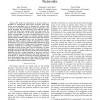180 search results - page 14 / 36 » Learning random walks to rank nodes in graphs |
PODC
2009
ACM
14 years 8 months ago
2009
ACM
Performing random walks in networks is a fundamental primitive that has found applications in many areas of computer science, including distributed computing. In this paper, we fo...
ICDM
2008
IEEE
14 years 2 months ago
2008
IEEE
This paper studies how to incorporate side information (such as users’ feedback) in measuring node proximity on large graphs. Our method (ProSIN) is motivated by the well-studie...
LCN
2007
IEEE
14 years 1 months ago
2007
IEEE
Abstract—We study the performance of several search algorithms on unstructured peer-to-peer networks, both using classic search algorithms such as flooding and random walk, as w...
WAW
2007
Springer
14 years 1 months ago
2007
Springer
Popular reputation systems for linked networks can be manipulated by spammers who strategically place links. The reputation of node v is interpreted as the world’s opinion of v�...
WWW
2002
ACM
14 years 8 months ago
2002
ACM
The Web graph is a giant social network whose properties have been measured and modeled extensively in recent years. Most such studies concentrate on the graph structure alone, an...

